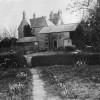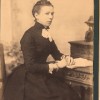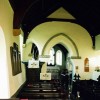Sometime in the year 1774 or possibly 1775 a young man still in his teens bade farewell to his parents at the family home in Chard, Somerset, and walked the twelve miles towards Lyme Regis on the south coast, to begin a new life of independence. Since it is thought that the boy already had an aunt living in Uplyme, just over the Devon border to the north of Lyme, he first lived with them, though he would later move down to become a man of property and renown in the town itself.
The youth was John Bennett, and his move to Lyme sometime after 1776 proved to be the starting pistol for a productive life spanning almost eight decades in the service of the town. However, John was just the outstanding ancestor; for he went on to sire a kind of dynasty of civic notables who in no small way through their own family lines temporarily replenished Lyme’s dwindling population during the years of its early 19th century revival as a health resort. Lyme built ships, caught fish, mended nets, wove silk, and traded cloth; here also William Pitt lodged, Jane Austen danced, Princess Victoria stayed and Mary Anning hammered fossils out of rock. Bennett’s arrival clearly coincided with an auspicious time for civic betterment and reconstruction.
From his relation’s home in Uplyme John would descend the steep hill to the town to work as an apprentice to a cordwainer (shoe-maker). This was an honourable trade of seven years indenture or training, and Bennett was no exception to the tradition of literacy and erudition among its practitioners; indeed he was noted for his steady handwriting and signature. John was also a competent violinist, who was soon playing at dances held at Lyme.
In September 1788 John Bennett married Maria Denning, a local women the about 25 years old in St. Michael the Archangel Church. Their first child was Henry, born in 1790, who was followed by Maria (1791); Elizabeth (1793); William (1794); Eleanor (1796); Mary (1797); Sarah (1798; Ann (1799); John (1801); Thomas (1803) and William (1804). Five of these children would survive childhood, but the first William died as a baby, as did Mary and Sarah in infancy soon after.
By 1800 Mr Bennett’s shoe-making business was prospering and in 1802 he rented a house on Bridge Street, off Cockmoile Square, next door to the home of the Anning family. Fossil-collector Mary was then just three; the two families never inter-married however, Mary dying a spinster. However, it has been suggested she may have fostered an interest in fossils in some of the Bennett grandchildren.
For another local family it was a different matter. Mr & Mrs Govis, regular customers of Mr Bennett, had a daughter, Mary, to whom Henry was strongly attracted – so much so that their first child, Henry Jr. was actually conceived before his parents wedded in November 1812. By this time Mr Bennett had deeply committed to administering St Michaels as a churchwarden and as a member of the town council. As Lyme became something of a mecca for health-bathing, he took possession of one of the town’s three public baths. When he wasn’t pre-occupied with his business, the Corporation, and the Church, Mr Bennett had to fight a lifelong battle defending his other properties from storm damage and coastal erosion.
Henry and Mary’s second son Edwin was born in December 1814, being followed by John (1817); Emily (1820); William (1821); Frederick (1824); Caroline (1825); Elisha (1829) and Augustus (1832). Of all John and Maria’s 11 children, Henry was the only one of two to establish solid, contiguous lines of descent. The other was John, who after his marriage to Eleanor Woodman in July 1825 had six children by her: Ellen-Kate (1826); John (Woodman) (1827); Charles (1830); Maria (1831); Joseph (1834), and Rose (1836). Born in Cerne Abbas in 1799, Eleanor came to know John as a friend of his younger sister Ann, with whom she entered into partnership running a millinery shop in Lyme. Between them these Bennett brothers would disperse the Bennett genes to other parts of the country and abroad.
Contrary to his father’s hopes. Henry Sr evidently had no leanings towards a cobbler’s life, finding his true vocation as a schoolmaster; being also a talented musician, he filled the position of organist at St Michaels and taught children music. His younger brother was not so fortunate. Mr Bennett taught his son the cordwaining business, but in 1837 John drowned when a boat returning him from Charmouth capsized in a squall.
Soon after their marriage John and Eleanor bought Malabar House, a fashionable property where in later years Eleanor was to become a warm-hearted mother-figure to her own children and some nieces and nephews. Now a widow she kept up her shop, though in 1832 Ann had married widower, Richard Cox, a saddler by trade in Bridport, and moved with him to that town, leaving Eleanor to run the millinery shop on her own. By Richard her sister-in-law had three children: John (1834); Emily (1836) and Richard (1838).
Of John and Eleanor’s own children Ellen-Kate married john Sharpe, a solicitor’s clerk from Norfolk in August 1853. She bore him seven children: John Woodman; William, Eleanor; Alice; Charles; Clara and Rosalie, between 1854 and 1858. Eleanor Bennett’s Charles married Elizabeth Smith in 1852 and emigrated to Australia, but died only eight years later from wounds sustained in a bizarre shooting accident in 1860. Buried in Geelong Cemetery, Melbourne, he left Elizabeth with two sons and a daughter to bring up. Maria, Eleanor’s second daughter, married Richard Loveridge, a London cheese-monger in May 1856. The couple had grandparents in common, for Richard’s grandfather, also called Richard, married old Mr Bennett’s sister Eleanor; he was therefore, Mr Bennett’s great-nephew. Richard and Maria had four children born between 1857 and 1862: Eleanor, Anne, John and James, but by the latter date these children were orphaned. They were adopted by grandmother Eleanor, and so went to live with her at Malabar House.
That left John, Joseph and Rose. John married Sarah Longhurst in Hackney in October 1870; at the time he was living and working with Joseph in Devizes, who like him had not remained in Lyme beyond childhood, but unlike him, had no recorded issue. Joseph married Jane Wing, a London girl, in the capital in January 1857. They had seven daughters and four sons. Rose married Thomas Brown, Lyme ironmonger, in January 1862. Their son and daughter were born in a house on the Cobb before the couple eventually went to live in London.
Of Henry and Mary’s branch of the family, Henry Jr married twice: first, Priscilla Loveridge in April 1835, and after her death, Martha Murley in October 1846. By Priscilla (apparently un-related to Mr Bennett’s sister’s family) Henry had three children: Henry Alfred; Esther, and Myra, between 1838 and 1841. He too became a schoolmaster and succeeded his father as organist at St. Michaels.
Henry’s brother Edwin married Emma Dunster, daughter of a local builder, in October 1834. The Dunsters, however, were better known as a Lyme family in the printing trade, and for a time Edwin went into partnership with them as Bennett & Dunster. By 1839 they had left Lyme, leaving the business to Daniel Dunster. Edwin and Emma had five sons and five daughters.
William, fourth son of Henry Sr married Elizabeth Spear, a London-born Bridport woman 20 years his junior, on Boxing Day 1864. The couple had four children: William Henry; Mary; Esther; and Minna, between 1865 and 1883. William became a prominent figure in Lyme and by 1880 he would be almost the last of the Bennetts still living in the town. One of his later duties was to collect harbour dues, but he was a gifted painter, mainly of the local land and seascapes, though he also painted portraits of his grandparents, old John and Maria.
Elisha married Sarah, though it is not certain who she was, whether Sarah Longhurst or someone else. After his brother’s re-marriage Elisha became a master mariner in South Shields. According to the recorded selective genealogy of the family neither he nor his siblings John, Emily, Frederick and Caroline, are shown as having any descendants, and of these, only Elisha married.
With the death of William in 1881 and Elizabeth’s move to Bridport with the children, the perpetuation of the Bennett line effectively ceases. Henry Jr’s last son Augustus is a progeny of particular significance, for he was the last Bennett to be living in the town at the time of his death in 1911. Eleanor Woodman Bennett, the home matriarch of Malabar House, died April 28th, 1873 in her 74th year.
As for John and Maria, the patriarch and matriarch of the extensive Bennett clan, they died in 1852 and 1831 respectively – but not before seeing about 20 of their 72 descendants born. Demographically, the family is interesting in that it appears to buck the trend for the period in two respects. Not because of the size of the generations, for ten to twelve children was the norm in the late 18th and 19th centuries. It is that at least one Bennett bride –Henry senior’s Mary – did not go to the altar as a virgin, and also the atypical longevity of John Bennett himself, in that he lived long enough to become a great-grandfather.
However, any diligent search for Bennett graves in the churchyard is likely to be futile. Although family members were buried in Lyme cemetery and at St Michaels, the area of consecrated ground at the latter that formerly included the Bennett plot has been reclaimed by the sea through landslipping.



